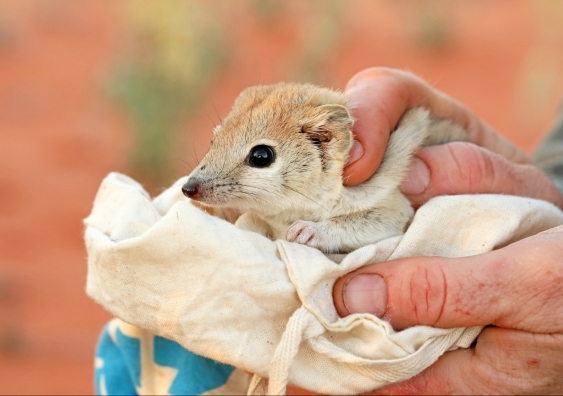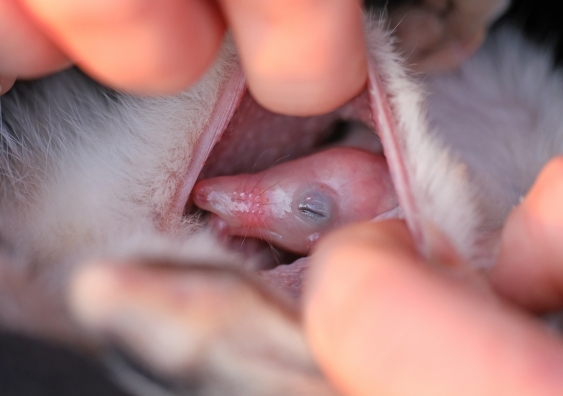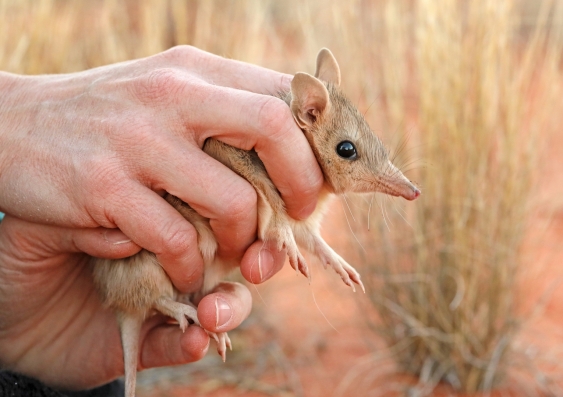Reintroduced mammals now thriving in Sturt National Park
This is the project milestone ecologists had been hoping for.
This is the project milestone ecologists had been hoping for.

Three native mammal species ā bilbies, crest-tailed mulgaras and Shark Bay bandicoots ā are booming since their recent reintroduction to Sturt National Park in the far-west NSW outback.Ā
These mammals were translocated to the area throughout 2020 and 2021 as part of , a UNSW Sydney-led conservation project aiming to revitalise the desert landscape by repopulating the park with small native mammals. The project is run in collaboration with Ecological Horizons, NSW National Parks and Wildlife Service, and Taronga Conservation Society.
Up until recently, bilbies, mulgaras and Shark Bay bandicoots were locally extinct in the region ā but todayās annual trapping survey results show the conservation work is paying off.Ā Ā
āOur crest-tailed mulgara populations have rocketed up to between 160 and 240 individuals,ā says Dr , Wild Deserts project coordinator. āWe originally only started with 19, translocated from wild populations in South Australia in August 2020.
āGiven each female can have up to eight young and conditions have been booming from rainfall in early 2021 and again in January this year, it has been the perfect opportunity for mulgaras to grow their population.ā
Crest-tailed mulgaras were the first mammals to be reintroduced to Wild Deserts, but bilbies ā who were reintroduced shortly after ā are already increasing their numbers, too.

Female bilbies bred at Wild Deserts are now having pouch young of their own. Photo: Tom Hunt.
āItās now estimated up to 60 bilbies are bouncing around their exclosures, including female bilbies bred at Wild Deserts who are now having pouch young of their own,ā says Wild Deserts principal ecologist, Dr .
āIt is really the icing on the cake to find new female bilbies that are also breeding.ā
NSW Environment Minister James Griffin says, āIām thrilled to see that this program, one of the most ambitious mammal rewilding programs in Australia, is going from strength to strengthā.
Read more:Ā
This bilby population has grown from an initial group of 10 greater bilbies reintroduced from Taronga Western Plains Zoo in September 2020, followed by another 30 bilbies in May 2021 from South Australian populations at Arid Recovery and Thistle Island.
Dr West says the 13 Shark Bay bandicoots translocated from Arid RecoveryĀ last May havenāt wasted time either ā their population is estimated to have doubled only six months after they were released.Ā
Even though female bandicoots can only have two young in their pouch at once, all of the six females translocated have already had two litters each since arriving at Wild Deserts.Ā
āIt was fantastic to catch new young bandicoots so soon after the translocation,ā says Dr West. āItās a great indicator of the projectās success so far.āĀ
Read more:Ā
Up until recently, Shark Bay bandicoots were one of five bandicoot species known as western barred bandicoots, a species that roamed around Sturt National Park 100 years ago. Recent taxonomic work has split them into five species, and only the Shark Bay bandicoots ā the species translocated to Sturt National Park ā survived on offshore islands in Western Australia.
āThese results are so important for the long-term goal of restoring this magnificent desert ecosystem back to something like it once was,ā says UNSW Professor , Wild Deserts project lead.

The initial bandicoot population introduced at the park is estimated to have doubled only six months after they were released. Photo: Tom Hunt.
The team compiled all this information from regular ecological monitoring surveys conducted throughout the year, which monitor how the animals have been faring.
While the team donāt catch every mammal, they use trapping data and modelling to estimate the size of each of the translocated populations.
āThese trapping and track monitoring surveys give us a great insight into the status of each of our translocated populations,ā says Dr West.Ā
āWe can look at the health and condition of animals, whether they have pouch young and whether there are any new recruits to the population.ā
Read more:Ā
The Wild Deserts team created one of the largest, feral-animal-free areas in Australia within Sturt National Park, eradicating every last rabbit, cat and fox from two 2000 hectare feral-proof fenced exclosures.Ā
These two exclosures are wild ātraining zonesā, where vulnerable mammals are learning to survive in the landscape without the danger of predators like cats and foxes. When their populations grow, the mammals will be moved into a second training area with predators, where itās hoped they will learn to become predator-smart.
The ultimate project aim is to release a smarter generation of bilbies and other locally extinct mammals back into the wild ā which will in turn help restore the desert ecosystem.
Project leader Prof. Kingsford says heās excited about the survey results.
āItās wonderful to see these animals back in their original home, prospering and restoring this desert ecosystem to some of its past magnificence,ā he says.
āEvery yearās results are exciting. We are looking to transform this environment out here by putting these animals back in and establishing food webs that were once here.āĀ
Based on the success of these three species, the Wild Deserts team are now planning to translocate a fourth species, the golden bandicoot, in 2022.